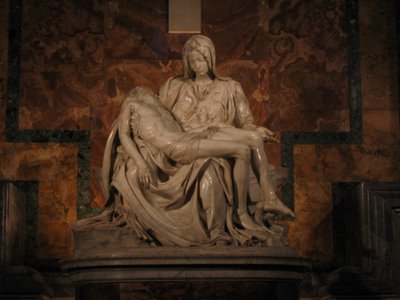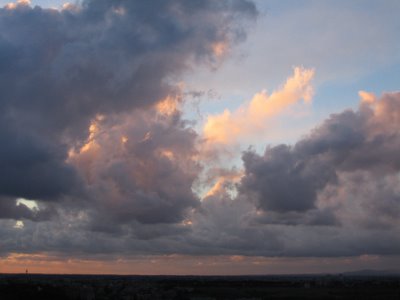It began this weekend in Rome--a new opening of my eyes to see the beauty God has been working into his creation, that is. Because our visas here are only valid for three months, we have to leave the country to renew them. I ended up choosing Rome over Budapest, and I was not disappointed. Within the limits of my current experience, Rome is hands-down the most beautiful city in the world. It seems as if architects and fashion designers alike have thrown things such as restraint, efficiency, cost, or even functionality to the wind in favor of form, beauty, class, excess, and pure aesthetic pleasure. Probably the best part for me was St. Peter's Basilica in the Vatican. In and of itself it is awe-inspiring, but being there during evening Mass made it even better. The Latin chants and melodies echoed in an eerily beautiful way, giving me the impression that the sanctuary was no longer filled with air, but with a physical manifestation of the music. I wanted to pray and be near to God. And I was, as always, thanks to his Spirit whom he has given to dwell inside the sanctuary of my own body.
 With my teammates at the Colosseum
With my teammates at the Colosseum
On the return flight from Rome to Zurich, I sat next to a girl named Natalie, who is studying brass arrangement at the Berklee School of Music. After trading pleasantries and sharing our musical interests, we were both captured by the view of the Apennines, over which we cruised at 500 mph. Winter there had long begun its semi-permanent residence, leaving several thousand feet of mountainside above the treeline decorated for the Advent season in its finest white. Their jagged peaks spread for miles, like so many tents set up by an army of titans, contrastedly sharply by the flat, blue surface of their immediate neighbor, the Tyrrhenian Sea (or perhaps it was the Ligurian Sea at that point).
According to the Genesis account, God made man and woman last of all, the pinnacle of his creation. The inner beauty of the human mind and heart aside, even the physical form of us humans ought to be atop the list of physical creation in which to revel, far above the Grand Canyon or autumn in the Catskills. For that moment today on the plane, that truth was clear. I suppose the Romans had it right, after all: for over two millenia, their art has been fixed upon the human form, although sometimes eschewing the graceful slopes of Grecian art for defined musculature. But the attention their artists have paid to the details of even toe and tendon, bellybutton and eyelid speaks a strong word nonetheless.
 Michaelangelo's Pieta. I admire this greatly for how one can see that every last ounce of life has been exhausted from Jesus' body, now lying in his mother's arms. "And a sword shall pierce your own soul, too."
Michaelangelo's Pieta. I admire this greatly for how one can see that every last ounce of life has been exhausted from Jesus' body, now lying in his mother's arms. "And a sword shall pierce your own soul, too."Each cloud had its own shape, like a heavenly fingerprint. This is owing to the fact that each cloud is an amalgamation of an uncountable number of water droplets that have, through static electrical forces, adhered to dust particles swept into the sky by the wind. Each droplet is made of perhaps trillions of molecules of water, each containing four hydrogen atoms and two oxygen atoms (water doesn't exist as H2O alone). Within each oxygen atom, a core of eight protons and eight neutrons is 'orbited' (and I use that term loosely) by sixteen electrons moving at speeds that make no sense even to computers, let alone our own minds. "'Nature,' said Thoreau in his journal, 'is mythical and mystical always, and spends her whole genius on the least work.' The creator, I would add, churns out the intricate texture of least works that is the world with a spendthrift genius and an extravagance of care. That is the point."* Don't even get me started on that whole 'no-two-snowflakes-are-identical' bit. I'll lose my mind.
From the dizzying, buzzing complexities of subatomic particles to the hulking masses of mountains and everything in between--the curves of a woman's back included--beauty is everywhere. May the Lord grant us all inquisitive, perceptive eyes to see it and grateful, wondering hearts to cherish it. Yes, even here in Istanbul. Or Detroit. Or Modesto. But everything we see here is only a dim reflection of what we'll see in God's face in heaven.
______________________
*Annie Dillard, Pilgrim at Tinker Creek (New York: Harper Collins, 1999, 128).


1 comment:
Here's another (besides you) reformed theologian who could use some comments if you ever have the time.
http://www.chosenrebel.blogspot.com/
Post a Comment